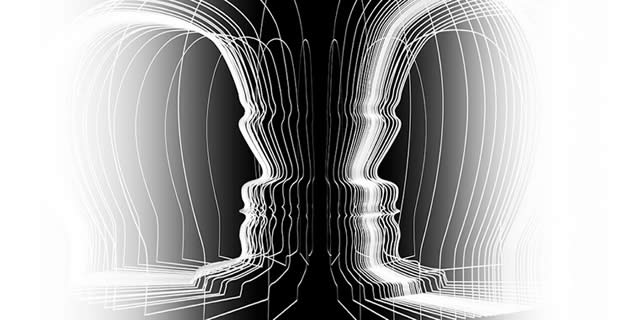PATRICK PALUCKI MULTISTABLE PROJECTION
Description The concept of complementarity has been introduced into quantum physics by Nils Bohr (Bohr, 1928) as a principle to describe complementary properties of objects such as the wave-particle-duality. Bistable perception of ambiguus stimuli has been used as a metaphor to describe this and even as an instance of quantum-like behaviour (Atmanspacher et. al., 2004, 2008). A visual example of bistable perception is the "rubian vase" - a face and a vessel both share the same contour as demarcation-line. Perception switches from one to the other in discreet time increments. I rotated this image around its y-axis. A 3-dimensional space unfolds and the vessel becomes an object surrounded by an x-number of faces. The higher the amount of faces the higher the plasticity of the object. I call it 'multistable projection' and I propose this as a model for a 'science of consciousness'. A science of consciousness has been felt as missing. One reason for that might stem from the fact that no single known scientific framework has been able to integrate or even describe all aspects of consciousness. When we acknowledge that significant information on consciousness is 'scattered' across many fields of inquiry, a working model of a science of consciousness should affirm an integration of relevant disciplines into the effort. A wider angle on the issues can be effectuated by stepping back and attaining a perspective of higher-order - one that integrates all singular perspectives and all forms of human inquiry and uttering that are relevant to these issues - be it quantum-physics, classical physics, chemistry, biology, neuroscience, psychology, sociology, anthropology, Hinduism, Buddhism, shamanism, art, system-science and so forth. In the picture, one discipline is signified by a single face. All the faces are looking at the vessel and are thereby constituting it. The vessel is the "holy grail" of consciousness. It forms with increasing detail as we take those multiple angles on it into account. The higher the amount of viewpoints the higher the understanding of the subject. The torus that is formed this way describes the science of consciousness. All disciplines are connected through that torus. Not the entirety, but only relevant aspects of one discipline may be taken into and out of account in a dynamic process of knowledge- and theory-building by cross-disciplinary induction and reduction during the regular process of scientific verification / falsification. One task in this science of consciousness is to mediate the findings of one science to the other and that means to translate one area-specific language into another. In this sense, a ’fluidity’ within the torus is created, so that insight and knowledge may roam freely through it. In other words, I propose a multistable projection as a working-model that is exploiting potential complementarities across the disciplines in the spirit of discovery.
References Bohr N (1928). "The Quantum Postulate and the Recent Development of Atomic Theory". Nature 121: 580–590. Bibcode:1928Natur.121..580B. doi:10.1038/121580a0. Available in the collection of Bohr's early writings, Atomic Theory and the Description of Nature (1934). Atmanspacher, H., Filk, T., and Römer, H.(2004): “Quantum Zeno features of bistable perception”. Biological Cybernetics 90, 33–40. Atmanspacher, H., Bach, M., Filk, T., Kornmeier, J., Römer H. (2008): “Cognitive time scales in a Necker-Zeno model for bistable perception”. Open Cybernetics and Systemics Journal 2, 234–251. H. Atmanspacher, T. Filk, and H. Römer. Complementarity and bistable perception. In Recasting Reality. Wolfgang Pauli's Philosophical Ideas and Contemporary Science, ed. by H. Atmanspacher and H. Primas, Springer, Berlin 2009, pp. 135–150.
Patrick Palucki Patrick Palucki is a media artist, commmunication designer and explorer of consciousness. He creates concepts of novel ways of communication and media application for emerging technologies. He has been long active as an innovator in applications of emerging technologies with f.i. custom-made software tools to create life-visuals like a musician (2000), interactive video-installations in (public) space (2000), video-environments and video-mapping for theatrical performance (2005), ultra-high-res composite photography (2005) and EEG visualizations in VR (2014). Contentwise his output encompasses works on consciousness in the fields of semantics, (sub)cultural mythologies, cybershamanism and neuroscience. In South Asia he spent five years in participant observation at the interface of Hindu-Buddhist and shamanic wisdom traditions, ritual and performance and co-produced several intensives on this topic. He studied media art, visual communication and design at Goldsmiths College, London and University of the Arts, Berlin. His work has been seen internationally on festivals, conferences, in single and group exhibitions and nationally in museal group exhibitions. It has been awarded with the Mandala Award of the European Institute for the Media, the Focus Award of the School of Applied Sciences Dortmund and the Special Prize of the Marler Video Art Award. Palucki also co-authored an operatic performance about climate change for the United Nations’ 60th anniversary in Asia which was performed in the conference hall of the UN headquarters in Bangkok, 2007. Palucki has presented at the conferences “Towards a Science of Consciousness”, Tucson, Arizona, “Science and Nonduality”, San José, California and “Transformative Technology”, Palo Alto, California. He is a visiting member of the Neuroscience Research Group (NRG) led by Dr. Michael Persinger at Lauentian University, Sudbury, Ontario, Canada. Palucki aims to create a novel fusion of consciousness, art & entertainment mediated by neurofeedback-technology.
|
|
|||||||||||||


